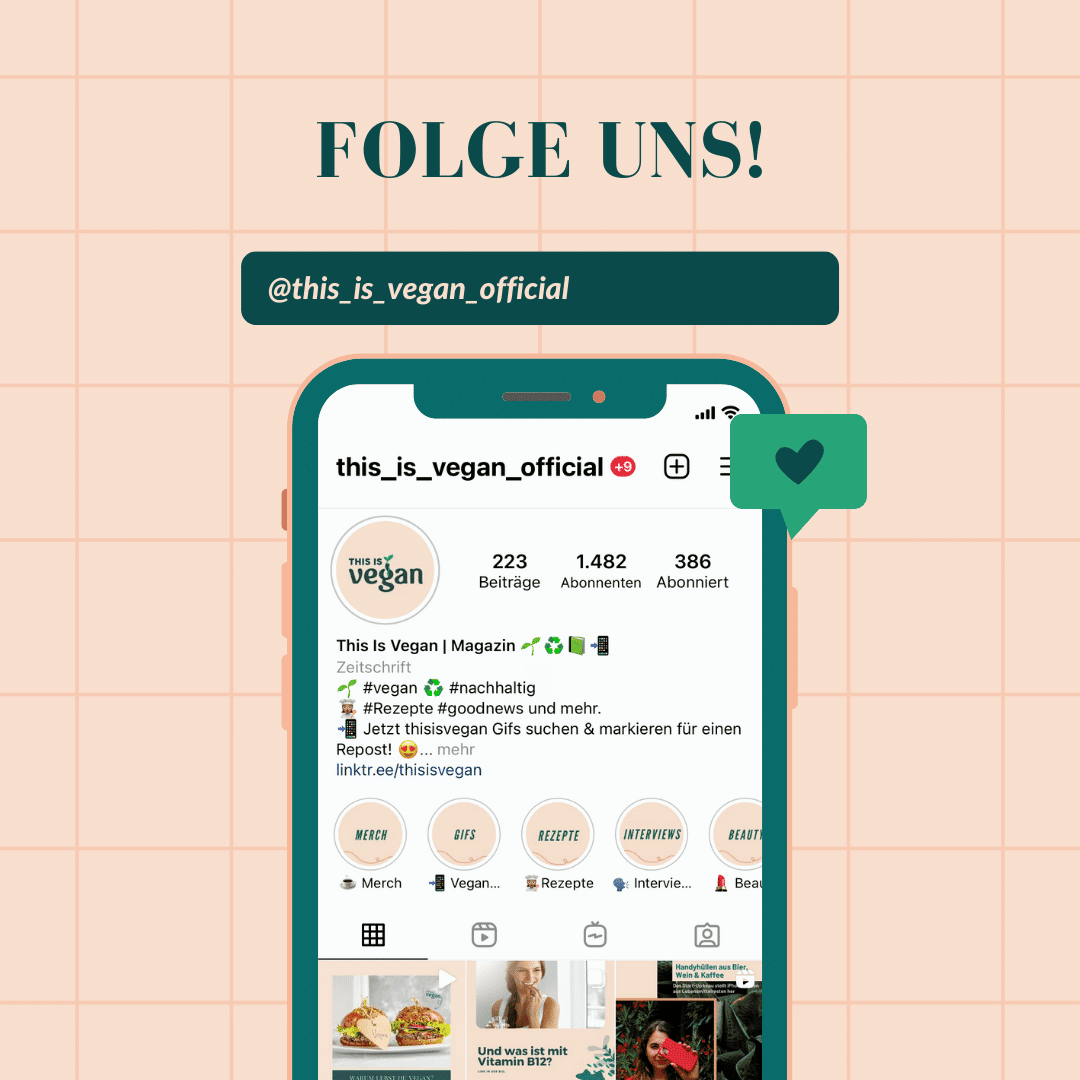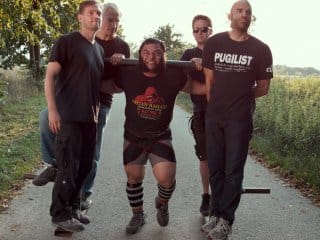Vegan on the Mount Everest – extreme mountaineer Kuntal Joisher in the interview
- Posted on
- 28 minute read
- Yannick
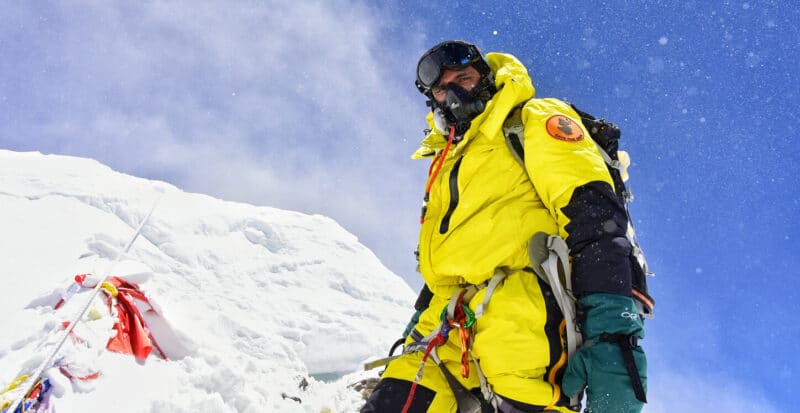
Indian climber Kuntal Joisher was the first person to climb Mount Everest completely vegan. Both his diet and all of his equipment are free of animal ingredients.
In 2014, during his first Everest expedition, an avalanche swept 16 climbers to the depths; a year later, during his second attempt, a severe earthquake caused the mountain to tremble, with 21 people losing their lives. Joisher narrowly escapes again, yet knows he will return. On May 23, 2019, at -50°C, the extreme athlete reaches the summit of the highest mountain in the world. Completely vegan.
In this interview, he tells us why he did it, what his most dangerous situations on the expedition were, what he did first on the summit, why he lives vegan, and why Oreo cookies and Coke are on his menu.
Why did you climb the highest Mount Everest?
Kuntal Joisher: I have now climbed four 8000m peaks (Manaslu in October 2014, Everest via the South Col route in May 2016, Lhotse via the Normal route in May 2018 and finally Everest via the North Col route in May 2019). However, mountaineering was never part of my life. At the beginning of my life, I dreamed of software technology. I wrote my first piece of software code in 1993, when I was in 8th grade. Somehow I knew I would be doing this for the rest of my life. And that is what I am doing today. I am a software engineer by profession.
Mountaineering, however, is a whole different story. In my craziest dreams I could not have imagined mountain climbing. There is no one in my entire family, extended family, or for that matter, my entire community, who has ever climbed mountains. The love of Everest possibly began for me as a teenager when I saw the PBS documentary Nova Everest, and I was fascinated by Everest. At the time, I had no idea what it would take to climb to the top of Everest – I just wanted to do it – it’s that simple. I had no inclination to pursue mountaineering or climbing as a passion. I may not have even understood what “passion” really meant, or there may have even been a word like “mountaineering.” I was happy in my world of friends and cricket, and that was all that mattered to me. But those images of the fearsome Khumbu Icefall and the magnificent 3000-foot ice wall of the Lhotse Face, the treacherous Hillary Step, stuck somewhere in my subconscious.
Up until a decade ago, if someone told me I was going to quit my job and become a mountaineer, I would have said, “What kind of drugs do you do?”
If someone had told me I was going to embark on a treacherous dream of climbing Mt. Everest, I would have said, “Are you crazy?” I was just a carefree software engineer, the guy next door who ran the nine-to-five rat race and lived a perfectly normal life. But one day that changed….
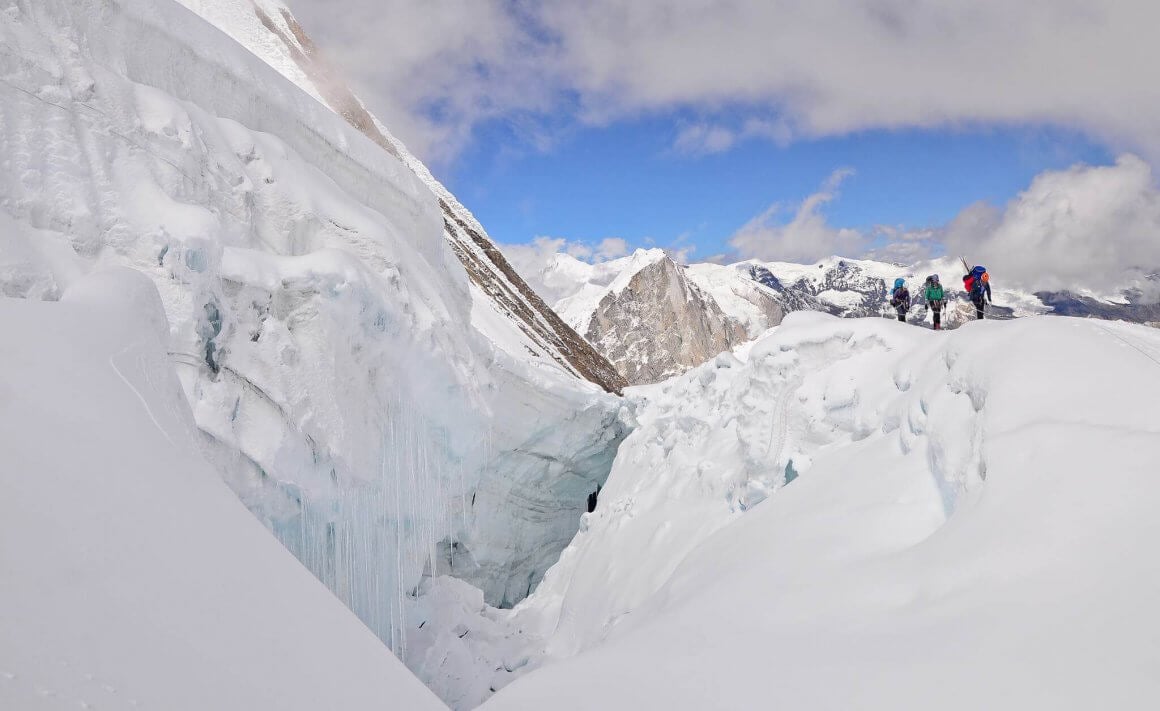
The most decisive moment of my life
My wife Dipti and I decided to take a vacation in Shimla in 2009. Shimla is located in the Indian Himalayas. We had a simple goal – we wanted to see snow. And that’s why we decided to go in the middle of winter. Six days passed and there was no sign of snow. On the last day of the trip, we decided to drive about 80 km north of Shimla to a place called Narkanda because a friend told us that snow would definitely be found there. After a long scenic drive on the old Hindustan-Tibet highway, we finally reached the place – a picturesque town in the Himalayas. And yes, there was snow. Dipti and I were both ecstatic. We were like little kids in a candy store. We played in the snow-angels, snowballs and all those things. We both sat down quietly and soaked in the beauty and grandeur of nature – and in that moment I felt something I had never felt before in my life. All the thinking about the past and worrying about the future melted away and the present moment was completely focused and I felt alive. I could hear my own breathing. Breathing is such an important function for human life, but I always took it for granted. And then I could hear my heart. Every single heartbeat. It was magical! For the first time in my life, I was at peace with myself, and I felt real, deep happiness. And at that moment, I decided that for the rest of my life – I was determined to follow that state of mind whenever I had the opportunity.
If you ask me about that one defining moment that changed my entire life – it has to be the one above. I knew that I would be in the mountains for many, many, many more years chasing that state of mind, which I would do.
Continuing my mountain journey, a few months later I signed up for a trek to Everest Base Camp in Nepal in October 2010. After a few days of hiking through one of the most spectacular Himalayan landscapes, we reached the base camp of a mountain called Pumori – the daughter of Everest. When evening came, our team had already gathered in the dining tent, which was an absolute luxury at 18000 meters! And then I heard loud noises outside the dining tent. Someone called my name. That’s usually not a good thing, so I ran outside….
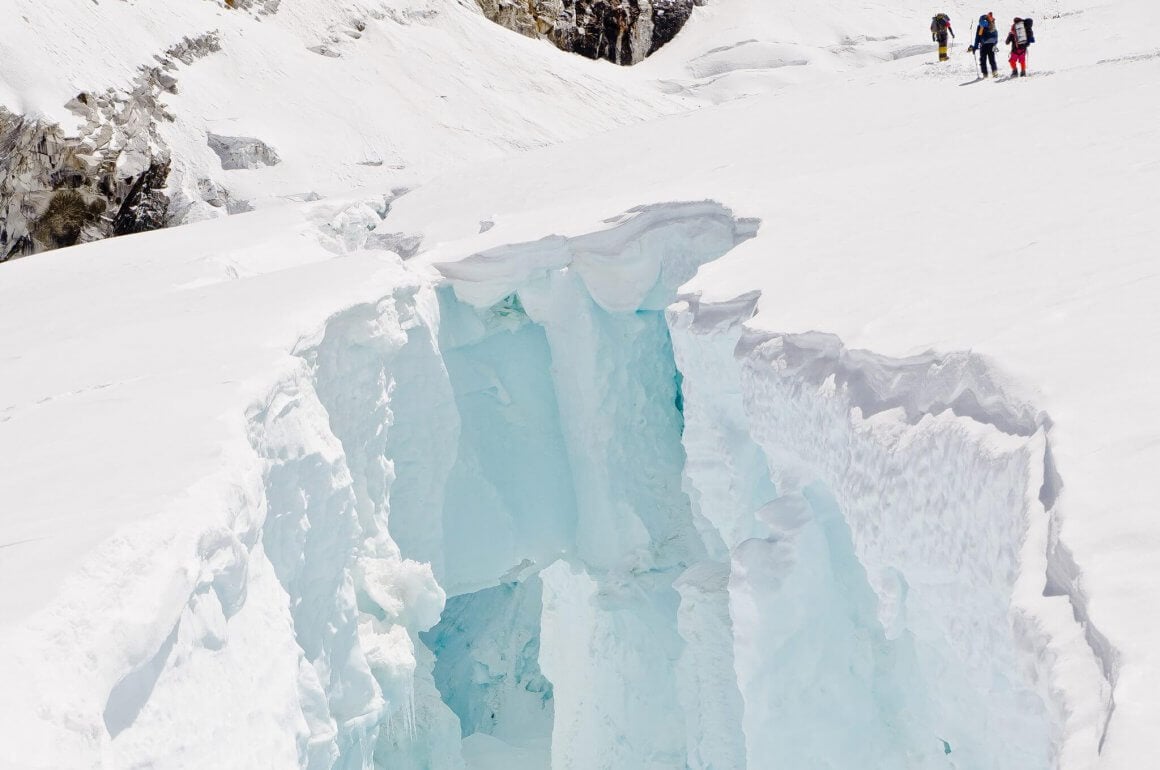
And then I saw the most magical scene of my life. The last light of the sunset fell directly on Everest. The other mountains were faded in the evening colors, but Everest burned with golden color, as if someone had set fire to the snow.
And right at that moment – I had found my dream. I promised myself that one day I would come back and climb to the top of Everest!

What was the most important part of your training in preparation for Mount Everest?
Kuntal Joisher: I understand that climbing the highest mountains in the world, like Mt. Everest is one of the toughest challenges and that I need to be in the best mental and physical condition of my life. And so I train hard 6 days a week. At the same time, a big aspect of success on big mountains is mental toughness. As the saying goes – “It’s all in the mind,” and I’ve experienced that firsthand on several of my climbs.
"I believe the key to achieving ironclad mental toughness is to put yourself in difficult situations and confront and overcome your fears!"
Kuntal Joisher
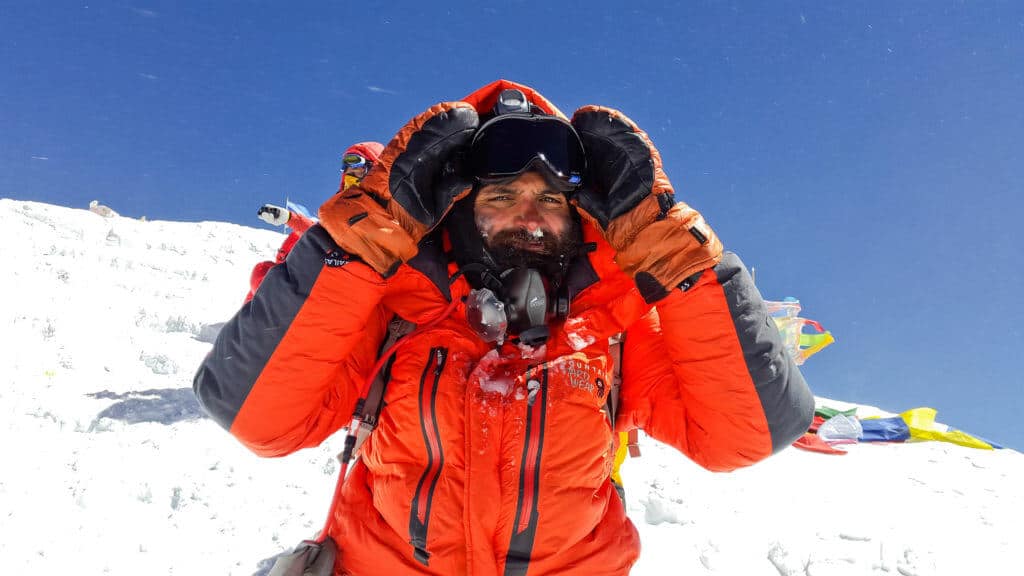
So I spend a significant time of the year hiking and climbing in the mountains near my home and in the Himalayas. Climbing and training on big mountains in the most hostile conditions of the year is what I consider good mental training. However, I can’t spend all my time in the Himalayas. So when I’m at home, I continue to do mental training. For example, I go on long, hard hikes without drinking water or eating anything. The idea is that something can go wrong when climbing a mountain like Everest. I can get lost, run out of food and water, and there can be any number of scenarios. Therefore, it is wise to train for such situations.
At the same time, I knew that if I were to succeed in climbing this mountain and coming back down alive in one piece, I would have to be in the best shape of my life – physically, technically, and especially mentally. The burning desire to stand on the “Top of the World” helped me to tackle the first two problems. However, I lacked the mental fitness to make it to the top. My greatest weakness was homesickness. Yes, you heard right: homesickness. I went on a climbing trip, and about halfway through, I thought about my father and wife and made up excuses to go home. I remember once saying to myself, “This snow slope looks avalanche prone, I need to stop and go home.” I had no idea about this slope! The rest of my team made it to the top. I regret the decision to this day.
"People who decide to climb Everest are crazy. Rationally and logically, no one does that."
Kuntal Joisher

Training until you pass out - the Mount Everest Workout
And one of the main reasons it took me a while to sign up for an Everest climb was that I knew I wasn’t ready. That’s when I decided to make changes. I began to emotionally detach from my family and friends. I went on mountain tours and rarely called home. Even when I was at home, I just completely shut down from my family life. I had no personal life. ZERO. And I started to train harder and harder. Several times I felt like I was going to faint. And sometimes I stopped, but at other points I continued to push my limits. I became mentally strong. Finally, I climbed three 20,000+ foot peaks in two months and knew I was ready to climb Everest. That was in 2013. Since then, my training has only gotten harder, and I don’t remember having a serious relationship with anyone in my family. WITH NO ONE. And now that I’ve climbed my dream mountain and I’m climbing more and more, I realize what I paid for it. I did not die. I have not lost any fingers. Heck, I didn’t even have a sunburn on my face. Of course, I didn’t have one either. I had trained harder than most people, at least I would like to think so. And now that Everest is no longer in my life, there is a huge amount of emotional emptiness. And I feel that this is the price I paid for climbing Everest.
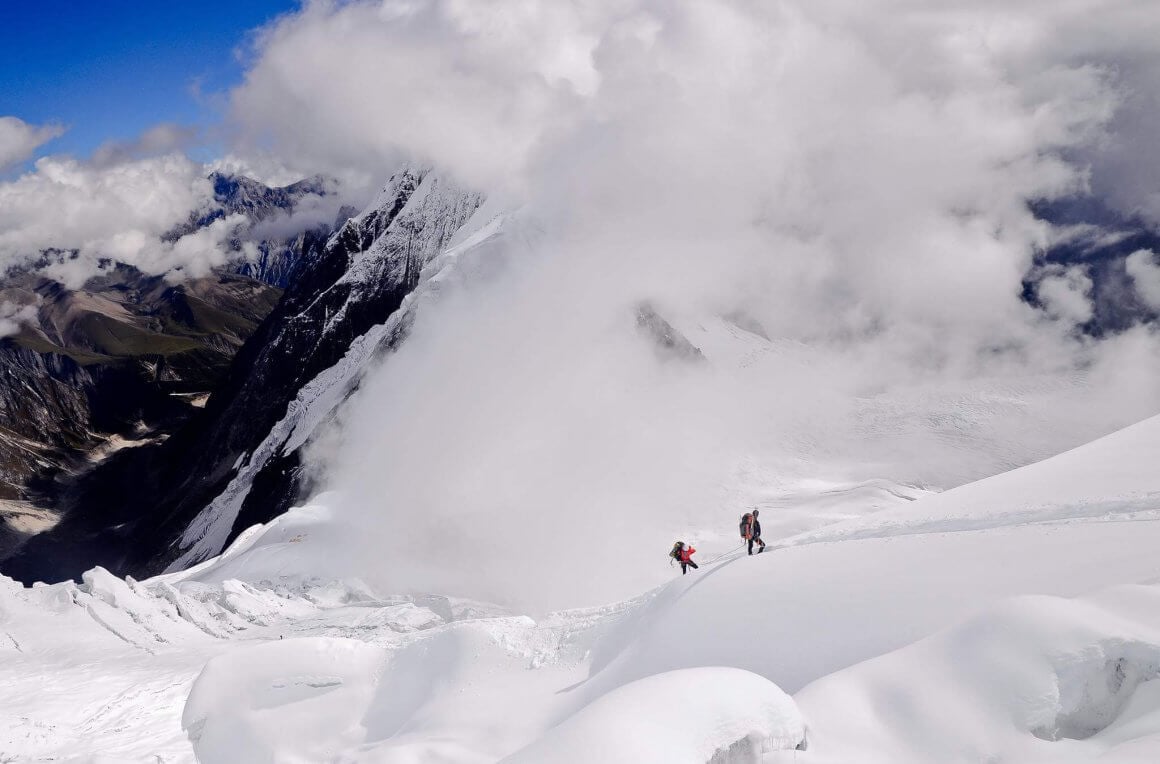
How did you come to eat a vegan diet?
Kuntal Joisher: I was born in a vegetarian family and consequently grew up as a vegetarian. I have always believed that “animals are sentient and emotional beings with individual character and have as much right to a free and happy life as we do.” Then I moved to the United States in August 2001 to get my master’s degree. At the end of 2002, my roommate at the university told me all about the horrors of the egg, dairy and leather industries. After that conversation, I connected the dots that a piece of meat, a cake baked from eggs, a glass of milk, a block of cheese or a leather belt or the down jacket I was wearing – are all the same and come from abused animals.
Think about where the milk we consume comes from…. Cows are always impregnated, their babies stolen and slaughtered for meat just so you can have their milk! Or think about eggs – male chicks are worthless to the egg industry, so every year millions of them are suffocated or thrown into high-speed mills and shredded while they are still alive. The birds are so closely packed together that they are forced to urinate and defecate on each other. Diseases are rampant in the dirty, cramped barns and many birds die! What about the leather belt or the feather jacket? These are made from the hides of cattle, horses, sheep, lambs, goats, pigs, elephants, snakes and feathers from chickens, geese, etc., all slaughtered to make you look good.
And then I learned more shocking facts. Animals raised for meat, eggs, and milk account for 14.5% of global greenhouse gas emissions, consume about 70% of agricultural land, and are a major cause of deforestation, biodiversity loss, and water pollution. After knowing all this, I lost my sleep and peace of mind. I couldn’t reconcile myself with the fact that as a vegetarian I was continuing to contribute to immense amounts of animal abuse, cruelty, slaughter, and destruction of the planet, so I had to take a stand. That was the moment I became vegan.
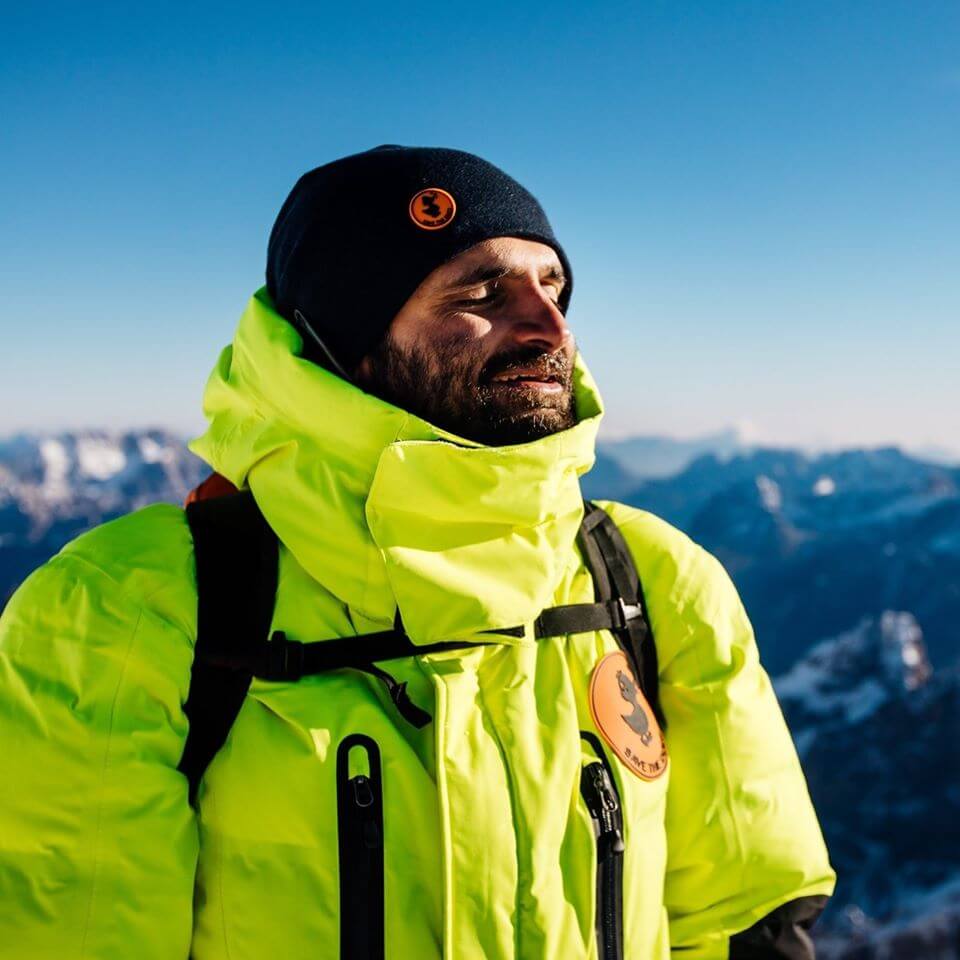
Vegan life - the attitude to life of extreme mountaineer Kuntal Joisher
For me, veganism means liberating animals and saving animal lives. That is the most important thing. The animals are here and share the planet with us, they are not here to be used by us. At the same time, if you understand the fact that animal agriculture is one of the largest contributors to greenhouse gas emissions, consuming the largest amount of food on the planet, resulting in forest land being converted to agricultural land to produce food for animals, large amounts of biodiversity and rainforest clearing, the planet’s water resources being under tremendous stress, then becoming vegan makes extreme sense, both for the animals and for the planet.
We as consumers have the power to change the world. What we buy is produced. When we buy more animal-free products, fewer animal suffering products are produced.
"Every animal wants to live, just like we do. Every animal loves, just like us. And every animal feels the same pain we do!"
Kuntal Joisher
I learned the true meaning of the words empathy and compassion the day I decided to become vegan about 17 years ago. It was the beginning of a new journey – like a rebirth. And it was the best decision I made in my entire life.
How exactly do you eat on such an extreme expedition?
Kuntal Joisher: At the end of 2002, I decided to become vegan. I have been vegan for 17 years now. Sometime in 2009, when I realized that climbing Mount Everest was the biggest dream of my life, I told myself that I would climb Everest as a vegan or not climb it at all. Most people in the high-altitude mountaineering world might think I’m crazy, since the recommended diet for extreme mountaineering expeditions includes salami, cheese, processed meats, eggs, and dairy. I can’t eat any of those high fat, high protein animal products. However, my diet was never a problem. I’ve been on over 25 serious Himalayan climbing expeditions now, and I’ve never had a problem being vegan, not even on this latest ascent of Mount Everest from the Chinese side in May 2019! As such, making climbing expedition food vegan is not that difficult. I have successfully worked with expedition operators’ kitchen staff in the high Himalayas in India and Nepal, and even in a remote region like the northern ice cap in Chilean Patagonia.
Whole foods and Oreo cookies
When I work out, it’s very simple – “whole foods plant-based.” Low fat, high carbohydrate. I love eating fruits, veggies, beans, lentils, whole grains, dates, nuts/seeds and this diet has done wonders for me. I recover much faster, even when doing some of the most painful workouts (example – a 20-hour steep hike in the local mountains). On the other hand, every time I eat unhealthy food like fried stuff/white refined flour, I have found that my recovery slows down. The body tells it what it likes. And my body likes a vegan wholefood diet. Some of my favorites are fruits like bananas, mango, grapes, and dried dates/raisins/figs, and I can’t forget – the oatmeal made with either water or soy milk (my favorite breakfast!).
As for my diet when climbing – it depends a lot on where I’m climbing. If it’s the Himalayas, most of the local food tends to be vegetarian, and it’s easier to veganize. Food typically consists of vegetable stews/curries, fruits, lentils, beans, soups, wheat bread, rice, potatoes, noodles, pasta, etc. So on my climbs in the Himalayas, I stick to the local cuisine. At the same time, I also carry around convenient food from home, which is more of a mix of dried fruits and nuts, nutrition bars made from dates and nuts, and a few local snacks, even if they are unhealthy (after all, calories are important in the mountains – calories are calories – you need them for energy!).
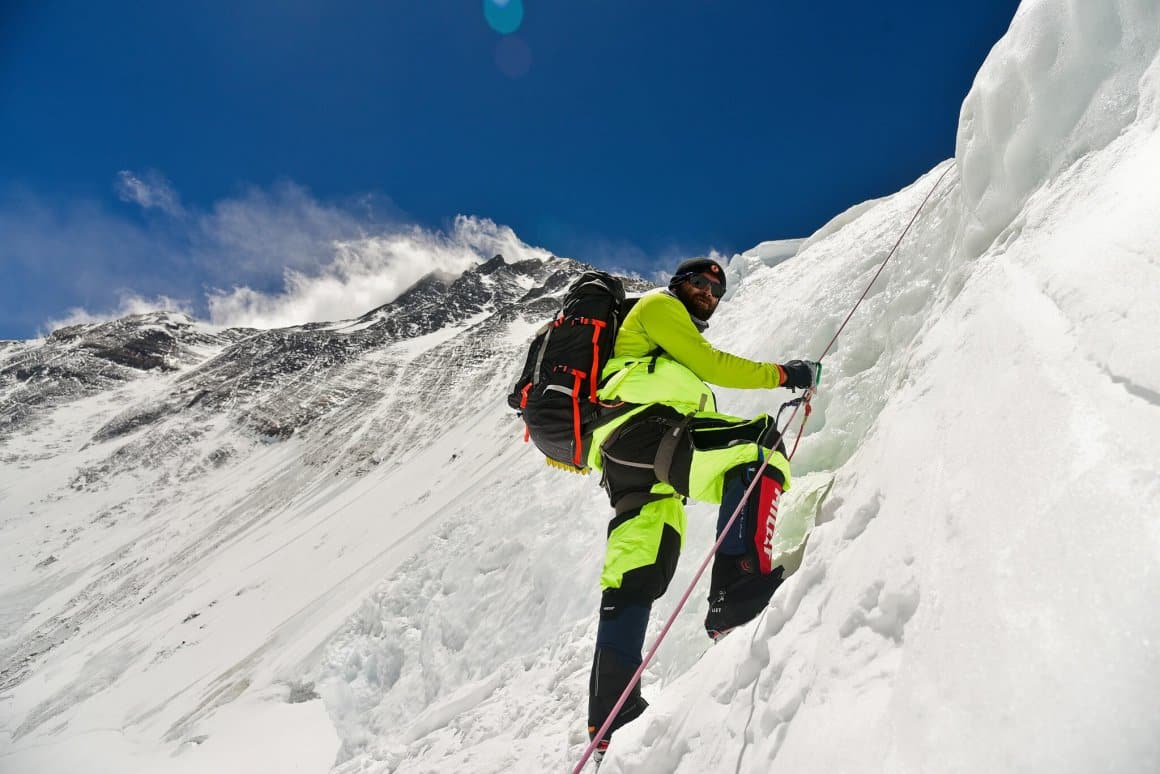
My diet during mountaineering expeditions is very different. At higher altitudes, the caloric needs of the human body are dramatically different than at sea level. At base camp, which is at 18,000 feet, a climber’s caloric needs could easily be around 4000 calories per day, and that number would easily increase to 8-9000 calories at 25,000 feet, and a climber burns about 15,000 calories on a typical 20-hour Everest summit trip. As long as the food on an expedition is vegan, I don’t care if it’s healthy or not. I eat it the way I need the calories. For example, a small bottle of 250 ml cola = 100 calories (99% simple carbohydrates). A single Oreo cookie = 45 calories, and so about 20 of them would be about 900 calories! These are all calories – vegan calories, and they taste great, and at 23,000 feet where most people can’t eat, I’d rather eat these and have my calorie needs met.
"When I need a lot of calories fast, Oreo cookies and Coke!"
Kuntal Joisher
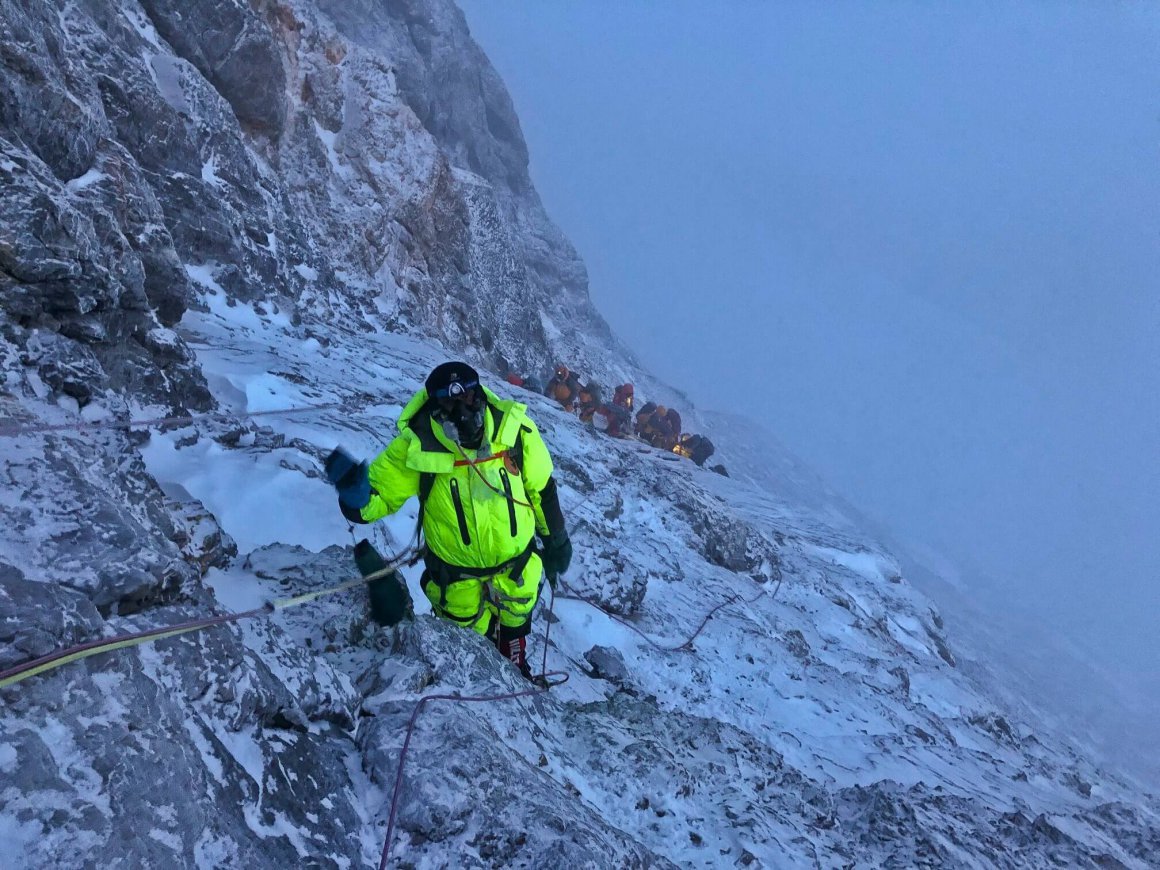
On the Everest/Lhotse climb, at base camp (18,000 feet) / camp two (21,500 feet) – I ate pretty much everything fresh, from whipped rice, to semolina/oatmeal, fried Indian bread and curry, Tibetan bread, pancakes, lentils and rice, noodles, fries, burgers, and various Indian foods – all vegan, of course. Our amazing chefs Ngima Tamang and Anup Rai even made us a vegan cake! Outside of the second camp, I survived mainly on a few things: Electrolyte and energy powders, freeze-dried meals, instant soy milk oatmeal, Oreo cookies, dried dates/ figs, dried fruits like kiwi, pineapple, papaya, nuts – almonds and cashews – and some Indian specialties.
When I switched to a healthy vegan diet, I had immediate performance benefits during my sea level workouts. My recovery time improved, and I was able to train harder and harder for the big mountain climbs! But one of the biggest benefits, and something that is not very obvious or tangible, is the level of mental calm and focus I have achieved after making the lifestyle change. Knowing that no animal or sentient being died for me to pursue my dreams gives me full peace of mind to focus and achieve my dreams. The vegan diet creates an essential mental advantage!
And having climbed Everest and Lhotse, I know that in the end it all comes down to your mental fitness and readiness.
Another advantage I have over other climbers, which I’ve noticed for several expeditions now, is that I never catch a stomach infection. Most climbers catch a stomach bug at some point during their expeditions, causing severe abdominal pain and loose movements, and these climbers tend to become weak, and some of them never recover and go home. In my opinion, most of these stomach problems are caused either by lactose intolerance or, on the other hand, by infected meat. As a vegan, I don’t eat living creatures or drink their byproducts, which means the chances of catching them are almost non-existent. I have also recommended to my fellow climbers to become vegan when they get infected, and it has worked wonders for most of them!

How do you meet your vegan protein needs while climbing?
Kuntal Joisher: Protein is an essential nutrient that is absolutely critical not only for building and repairing muscle tissue, but also for maintaining a variety of important bodily functions. Your body contains thousands of different proteins that perform different functions and are all made up of amino acids. It is the arrangement of these amino acids that determines the nature and function of a protein. There are 20 different amino acids that combine to make proteins, and although your body needs all of them, you can only make 11 of them. These are called non-essential amino acids. The other nine, which you cannot manufacture, are called essential amino acids and must be obtained from food. But these nine essential amino acids are hardly the exclusive domain of the animal kingdom. In fact, they are originally synthesized by plants and are found in meat and dairy products only because these animals ate plants. Basically, all animal protein is essentially recycled plant protein.
Supply all essential amino acids vegan
While certain foods – such as soy, buckwheat, etc. – contain all nine essential amino acids in roughly equal amounts, other plant proteins have a lower amount of at least one essential amino acid. But that’s not a problem because your body does the work of making complete proteins for you. The body creates a “pool” of amino acids from the food you eat throughout the day. So if you eat oats in the morning, a salad at lunch, and legumes in the evening, your body will gather all the essential amino acids from these foods and use them as needed to make protein. This means you don’t have to worry about getting all the essential amino acids at a given meal. As long as you eat a variety of plant-based foods throughout the day, your body will do the rest.
I’ve been vegan for 17 years, but I’ve never had any problems building lean muscle mass on a vegan diet. Everything from an apple to a bunch of spinach leaves, a potato, a block of tofu, kidney beans, lentils, whole wheat bread, a bowl of brown rice, soy milk, etc. contains amino acids. Every plant food has amino acids. And so I focus on eating a variety of fruits, vegetables, legumes, and whole grains mixed with small doses of nuts and seeds throughout the day, and I’m pretty sure that with the kind of workouts and expeditions I’m doing, I’m getting all the protein I need.
Was the clothing on your Mount Everest expedition completely free of animal ingredients / vegan?
Kuntal Joisher: I first became vegan, and then Everest came into my life. When news of my expedition to Everest as a vegan spread through the mountaineering community, there was a lot of skepticism from the community. But I told myself that I would climb Everest as a vegan or not at all. One of the biggest myths about vegan diets is that they are nutritionally deficient because they lack protein. I wanted to dispel this myth. I wanted to climb to the top of the world in the harshest conditions and show the world that vegan products are not only compassionate, but also of the highest quality – both from a nutrition and equipment perspective.
The difficult thing was to find vegan gear, that is, gear without leather, down and wool. When my climbing journey began, I was quickly able to find substitutes for leather, down and wool as I only climbed smaller mountains up to 6500 meters. Finding synthetic thermals was super easy, as were hiking boots without leather and even a sleeping bag and puffy jacket without down feathers. Most of the major manufacturers already had synthetic gear. Patagonia had thermals, La Sportiva had hiking boots, North Face had a sleeping bag and jacket – and so it was all possible.
Vegan winter jackets? Not so easy!
However, when I was ready to climb Everest, I realized that there would be two critical pieces of equipment that would be a problem. A one-piece climbing suit and high mountain mittens. The suit is one of the most critical pieces of gear built to withstand high winds and temperatures down to -50°C, and every single suit on the market has been made from down feathers. The mittens that were supposed to protect my fingers from frostbite were made of both down and feathers. Before my first attempt to climb Everest in 2014, I wrote to several major companies, including North Face, Mountain Hardwear, Rab, to name a few. My request to them – please create a synthetic one-piece for my Everest expedition. PETA representatives also met with people from the North Face who made the same request on my behalf. They all rejected the idea, saying it would be next to impossible to pull off. The answer was always the same: “The technology to replace these materials doesn’t exist for expeditions like this.”
I was very disappointed. I decided to build my own synthetic suit from synthetic Primaloft material. I quickly realized that the final product would be so bulky and heavy that I would almost look like a Michelin man. But more than that, the suit would be impractical for large-scale mountaineering. At the end of this whole exercise – I gave up. It doesn’t happen too often, but I did.
I reached the summit of Mt. Everest in a down suit. Since that day, I spent my time in serious guilt over my actions of using a down suit, as well as mittens with leather palms, but guilt was not the answer. The solution was to find a reliable and safe vegan alternative to down and leather that would keep me warm and safe while above 8000 meters in the death zone in thin cold air.
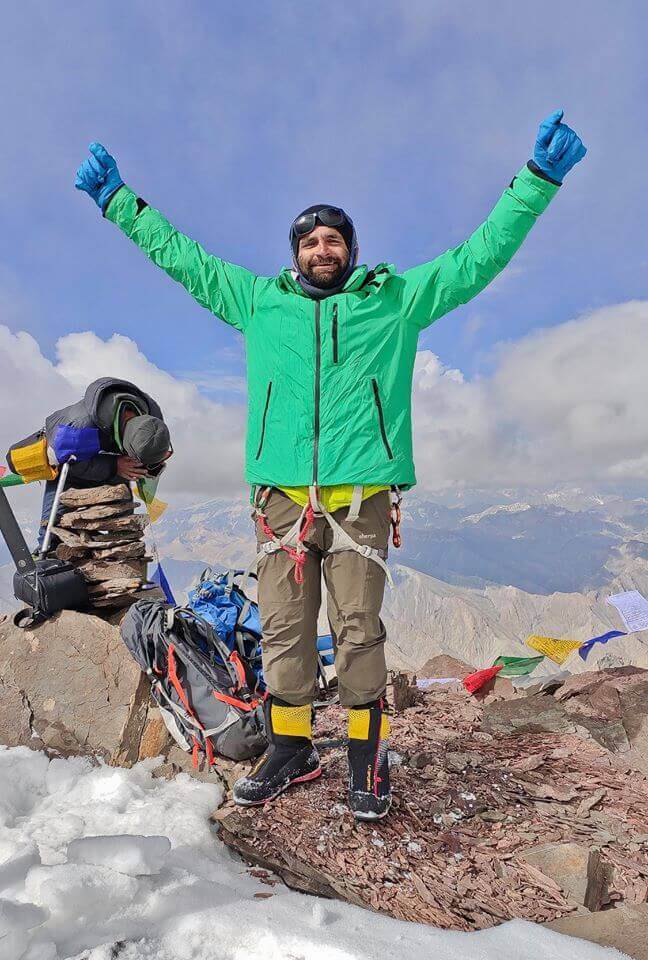
When I came home from Everest, I thought about climbing to the top of Mt. Lhotse in the spring of 2018 after. And this time I didn’t want to compromise and carry a dead animal on my body. So I started looking for a pet-free suit again. I wrote to a company in Italy called Save the Duck, which specialized in making down jackets. They didn’t have any mountaineering gear in their catalog, but they agreed to work on one for me because we both had the same vision. I was ecstatic! After about 8 months of research and development, they produced the world’s first one-piece suit for 8000m mountains; down-free and made from 50% recycled materials – discarded plastic bottles and fishing nets. Good for the animals and the planet.
However, there was one final challenge – finding and manufacturing synthetic high-altitude mittens. For the mittens, I worked with a local trekking store in Kathmandu. Since my Everest success in May 2016, after returning from Everest, we had been discussing the possibility of making our own synthetic gloves. And when I knew I was going to climb Lhotse, I visited Biden in Kathmandu to talk about the mittens. This time we sat down and discussed technical details of the glove. What kind of insulation, palm grip, upper material, seams, etc.. About 30 odd years ago, Biden himself was a mountaineer who climbed several 8000-meter mountains. And in recent decades, it has been one of the trusted outfitters for several major 8000-meter expeditions. He understood all the details and promised that my 100% animal-free gloves would be ready by the time I landed in Nepal in the spring of 2018. And he kept his promise.
My dream of making a real vegan 8000 meter first ascent no longer seemed impossible. But I was also afraid. I would risk my life and my fingers and toes high up in the death zone in freezing cold, strong winds and thin air. The suit and mittens had never been tested under these conditions. But I was ready – more than ever – for the animals!
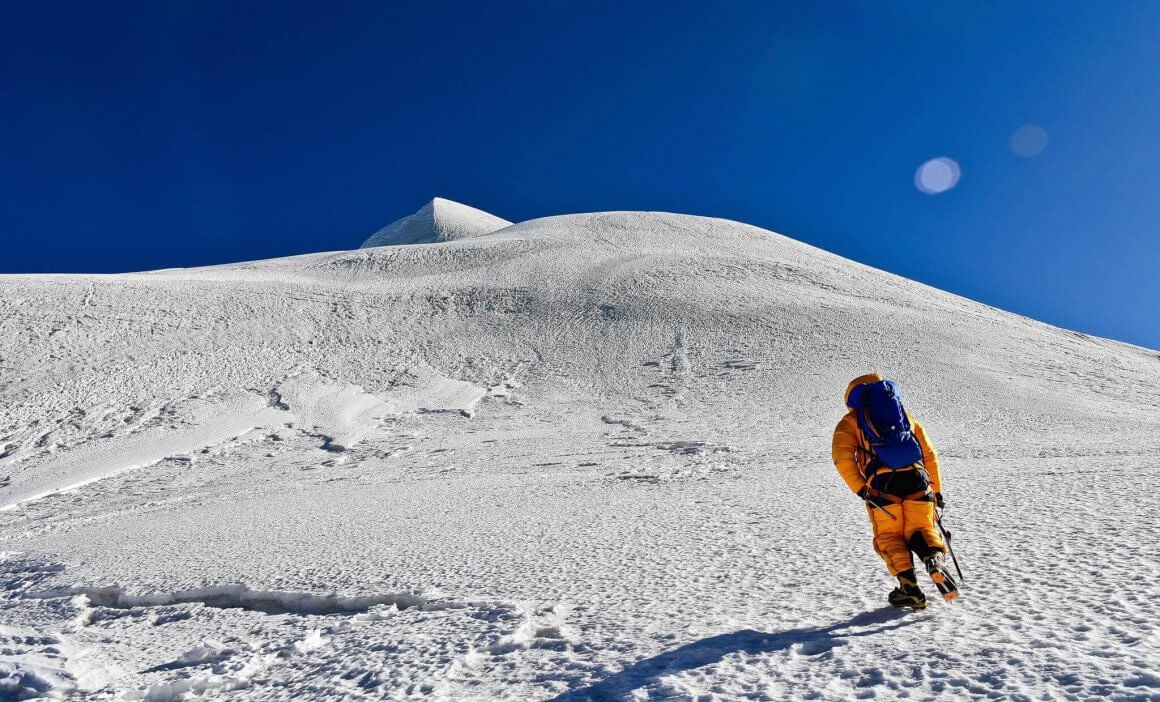
On May 14 in the morning our team got caught in a heavy storm while ascending from camp 3 to camp 4. Visibility was almost zero, and the wind gusts were incessant, sometimes reaching 70 km/h. For a moment I thought I was going to be thrown off the mountain face. One of the Sherpa guides and his client, who was climbing behind me, were also talking about abandoning the expedition. I didn’t want to go anywhere, I just wanted to go up. With a strong wind, the entire route was gone and everything was covered with powder snow. My crampons were buried in the terrain. And for the first time in the expedition, I was worried that it would get extremely cold and I would have to turn around and go home. But that didn’t happen. The one-piece synthetic suit from Save The Duck worked like a miracle – it protected me from both the gusts of wind and the biting cold. I knew then and there that I had a world-class product on my body and that I would make it to the top warm and safe.
On May 15 at about 3:00 in the morning we started from camp 4 to climb to the summit of Lhotse. It was freezing cold. But I was warm and toasty in my suit. Around noon I made the last steps and was on the summit of Lhotse! Honestly, this had been one of the toughest expeditions of my life. And I was pretty knackered at the summit. My greatest joy, however, was climbing without down or leather – and possibly becoming the first person ever to complete an expedition to the summit of any 8000 meter mountain as a 100% vegan!
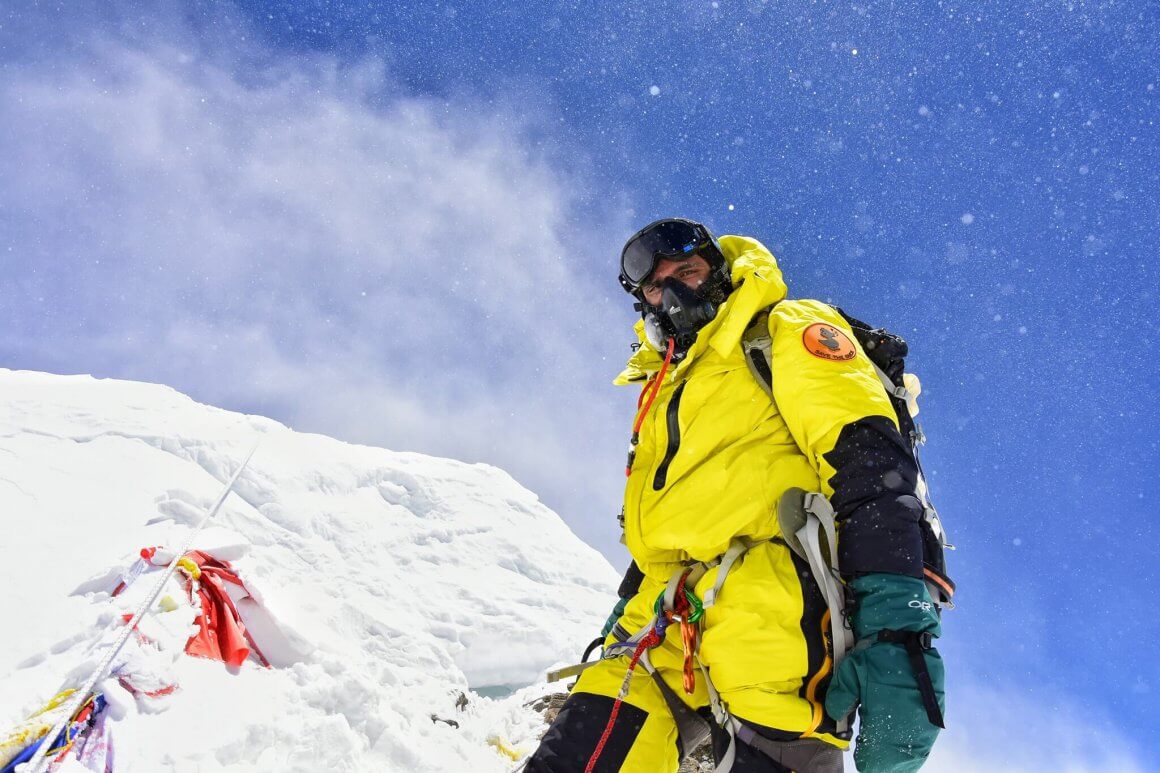
"I had to choose the strictest conditions to show the world that, vegan diet and equipment are not disadvantages - quite the opposite."
Kuntal Joisher
After I did that, I decided to go to Mt. Everest to return! This time I decided to climb from the Chinese side, which is harder and tougher. I had to choose the most stringent conditions to show the world that if I could survive as a vegan under these conditions, it would mean that the vegan diet and equipment would be just as good, if not better, than the non-vegan options we have.
In April 2019, I found myself once again at Everest Base Camp, hungry to fulfill my long-held dream. After about 45 days of climbing, I reached Camp 3 on May 22, which at 27,200 feet is the highest camp site in the world and is located in an area designated as the Death Zone. The air up here is so thin that you can only spend a little time here. Around 9:30 p.m., Sherpa Mingma Tenzi, my trusted climbing partner, and I began our final push to reach the summit of Everest. Due to the strong winds and poor weather conditions this year, the route to the summit was mostly a mixture of rock and ice. As we climbed through the night, we came across the bodies of four deceased climbers from years past, well preserved and a stark reminder that if I made a mistake, I too would be there forever. We stayed razor-sharp focused, and at 5:30 the next morning I took the final steps to reach the summit of Mount Everest.
"I had finally achieved the biggest dream of my life - a 100% vegan climb of Everest! This time I proudly flew the Vegan flag at the summit, knowing that no animal had to suffer or die for my dream to come true!"
Kuntal Joisher
Warmth and function of the equipment are two of the most important aspects. From this perspective, my animal-free equipment performed just as well (if not better) when compared to animal-built equipment. The equipment I used on Lhotse and Everest is currently not commercially available and was built specifically for me. So hopefully the next step would be to make this equipment commercially available so that climbers around the world can make cruelty-free and sustainable choices. Synthetic gear is warm, keeps you safe, and most importantly, good for the animals and the planet.

So the first thing at the summit was a photo with the Vegan flag?
Kuntal Joisher: Right. I have reached the summit of Everest twice now. Once in May 2016 and once in May 2019. Both times, the very first thing I did at the summit was take a picture of me with a vegan flag to announce to the world that no animals have to suffer or die for our dreams to come true!
What was the most exciting situation on the expedition?
Kuntal Joisher: My first attempt to climb Everest was in the spring of 2014. Originally, our expedition was scheduled to begin on April 1, and on April 18 we were to complete our first climbing rotation through the treacherous Khumbu Icefall. This was the same day as the avalanche tragedy (which killed 16 Sherpa guides). Due to complications, our plan was delayed and we started the expedition on April 3 instead. Despite the late start, our team made good progress and got us on track to make the first visit to the icefall before the end of April 18. However, my bags with all our technical equipment never arrived at base camp, so our schedule was delayed again. Call it fate or destiny or luck or whatever, we never went through the icefall on April 18, and I stayed alive to tell the tale.
Despite the support of my family and team, I finally made the decision to postpone my long-awaited promotion until next year. It was not an easy decision. I had trained for years for this moment, only to have my dream literally tumble down the mountain. But 16 Sherpa guides were lost to the mountain, and I was devastated. At the same time, I was grateful beyond words for my safety. The mountain was there long before me, and it will remain for many millions of years. I said to myself – I can wait an unimportant year to see him again.
My second attempt to climb Everest took place in spring 2015. By April 25, we had completed our first acclimatization climb to Camp Two on Mount Everest. Our team had descended, and we had all gathered in the dining tent. We discussed our climb of the last few days. And then suddenly the ground began to shake. I could feel it. I tried to tell everyone what I had just felt. One of my teammates said, “You seem to be suffering from altitude sickness!” What can actually happen – when you think you feel something, but it’s all in your head. And then the ground began to shake more strongly. This time, however, everyone took note. I yelled, “Earthquake!” and we all ran out. The whole floor shook like I had never felt before. It was like I was standing on a swing that was swaying a lot! Since we were stationed on a glacier, some people were afraid that the ground beneath us might open up and swallow us whole, like in a cartoon. It was unlikely, but it was a huge block of ice that could break apart. I was startled. Everyone was afraid. In every direction we could see people from their camps standing and nervously looking in all directions. By this time, the earthquake had been going on for a while. For someone who has never been in an earthquake, it doesn’t happen all at once. Shaking can last 30 seconds and sometimes up to 2 minutes. For us, it lasted about 60 seconds, then it stopped.
For a moment we were relieved, until we heard the loudest sound of our lives – it was like a huge bomb explosion. Based on the direction of the sound, we all looked east, toward Everest, to see what was happening. But it only took a few seconds to realize that something was wrong. We saw several people running towards Everest. And I thought to myself: How can that be possible? Why should people run the risk?
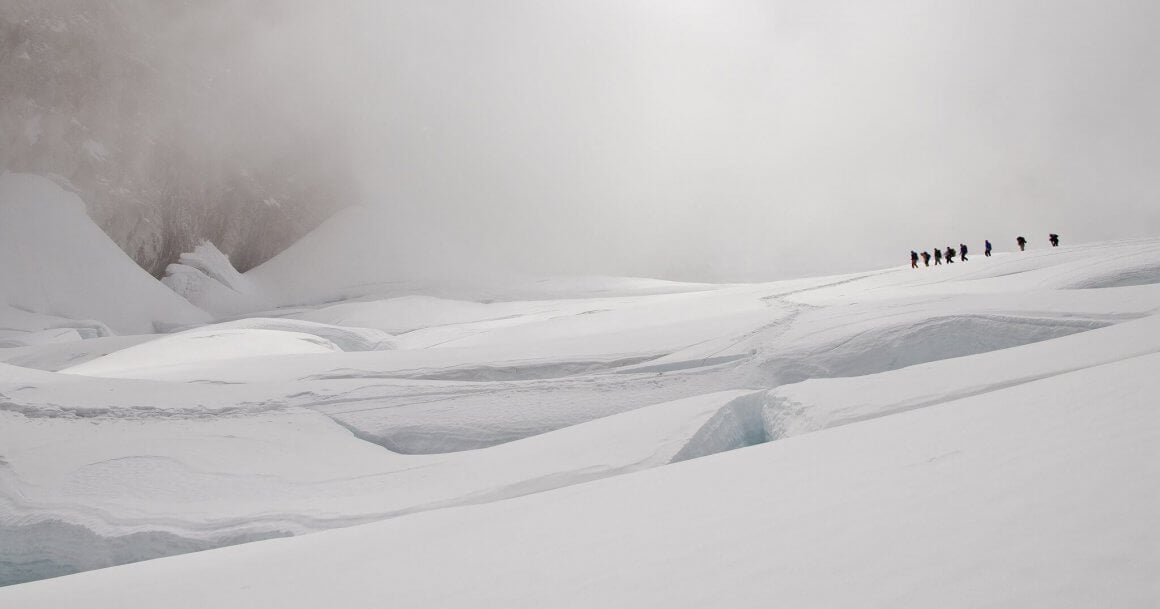
And that’s when I realized that an avalanche had formed right behind us. A huge block of snow and ice the size of a cricket stadium had broken off the summit of Mount Pumori, a few hundred meters west of base camp. The block fell from the mountain at an unreal speed, and when it hit the ground it turned into a huge aerosol cloud of snow, ice, and debris that was moving toward the base camp at about 250 km/h. The block was then dropped from the mountain at an unreal speed. We turned around and faced this huge white cloud of snow and ice. The word “huge” doesn’t even come close to it. It was like something out of a nightmare. It was the biggest thing I had ever seen in my life – it took up the whole sky as far as I could see from left to right. The only thought that crossed my mind at that moment was that I was going to die. I knew I was going to die. I remember feeling a strange kind of emptiness, a sadness I had never felt before.
I wanted to scream out loud. I did not want to die. There were so many things I still wanted to do. But I had nowhere to run, nowhere to hide. When I stood on a Himalayan peak a few years ago, my life changed. And now my life was about to change again.
I was with two other teammates when the avalanche cloud hit us. We jumped behind a tent as the cloud hit. Within seconds, we were all covered from top to bottom in inches of snow, cutting off our already thin oxygen. I could no longer breathe. I felt like someone had put a plastic bag around my face. It took superhuman effort to suck air into my lungs. For when the huge block of ice broke and landed, it set in motion a cloud of snow that was not air but pure aerosol. There was no oxygen in it. I would have surely suffocated if my good friend Jost had not seen my struggle and opened his jacket, which still had oxygen in it, so that I could put my head inside and breathe. Those first molecules of air entered my lungs, making me feel like a newborn baby taking its first breaths. I had received a second life. I knew then, and I will know for the rest of my life, that I will forever be indebted to Jost for saving my life.
We had no idea when the cloud would stop and what would happen next. A few minutes later, the cloud passed, and there was an eerie stillness in the air. More than anything, I was relieved to be alive. We counted through our entire team. Everyone was fine, but a significant portion of the base camp was devastated, equipment torn, debris everywhere, it was like a war zone. Later we learned that more than 20 people had died and over 60 had been injured.
Anyway, we knew that what had happened to us was tragic, but when we heard from friends in Kathmandu about the devastation in Nepal, we were heartbroken to learn that more than nine and a half thousand people had died, tens of thousands were injured, and more than half a million were displaced from their homes. It was a disaster of unprecedented proportions. As the leader of the team, I sat down with the Sherpa Sirdar and we decided to abandon the climb. It made absolutely no sense to climb the mountain. It was just too risky. After the shocks and avalanches, we continued and I had no intention of putting more lives in danger. I also wanted all my staff to go home and be with their families in their time of need. And above all, further accidents on the mountain would divert all attention from the immense tragedy that had occurred in Nepal. It was time to return to Kathmandu and see if we could help in any way.
This near-death experience during the 2015 expedition was one of the most dangerous moments of my entire trip. There is a video of this whole experience that my teammate Jost happened to take just at that moment.
What would you like to say to the readers in conclusion?
Kuntal Joisher: When I climbed Everest, I risked my life to prove to the world that we don’t have to exploit or kill our fellow human beings. Every time I stood on the mountain and wondered why I should put myself in a situation where the weather, the terrain, and everything else was not conducive to human survival, I reminded myself of the animals that suffer so much every day in factory farms, dairies, butcher shops, restaurants, and everywhere else for human convenience and pleasure. The only difference is that I chose to go through the tough conditions in the mountains to fulfill MY dream. Unfortunately, the animals do not have this choice, we deny them this choice.
We all simply have no excuse not to go vegan! Going vegan is the bare minimum we can do – for the animals and the planet!
More about Kuntal Joisher:
www.kuntaljoisher.com/
www.instagram.com/kuntalj/
Photos: Kuntal Joisher & Save The Duck
Nächster Artikel
Niko Rittenau about myths around vegan nutrition
- Posted on
- Yannick
Empathy in the belly – Oli P. on vegan nutrition, animal welfare and sustainability
- Posted on
- Yannick
Vegan nutrition against the Corona virus – Dr. med. Petra Bracht in the interview
- Posted on
- Yannick
Veganuary! CEO Ria Rehberg about new records at vegan month 2023
- Posted on
- Yannick
Vegan is unhealthy?! Gordon Prox on the future, his start-up and family
- Posted on
- Yannick
Vegan athletes: Top 10 athletes & their plant-based diet
- Posted on
- Daniel Köhler
Pens to plant! – Interview with Sprout World founder Michael Stausholm
- Posted on
- Yannick
The Hype Around Oat Milk – The Oatly Germany CEOs in Interview
- Posted on
- Yannick

